Abstract
Cu2ZnSnS4 nanoparticle with an average diameter of approximately 31 nm has been successfully synthesized by a time effective microwave fabrication method. The crystal structure, surface morphology, and microstructure of the Cu2ZnSnS4 nanoparticle were characterized. Moreover, the visible light photocatalytic ability of the Cu2ZnSnS4 nanoparticle toward degradation of methylene blue (MB) was also studied. About 30% of MB was degraded after 240 min irradiation when employing Cu2ZnSnS4 nanoparticle as a photocatalyst. However, almost all MB was decomposed after 90 min irradiation when introducing a small amount of H2O2 as a co-photocatalyst. The enhancement of the photocatalytic performance was attributed to the synergetic effect between the Cu2ZnSnS4 nanoparticle and H2O2. The detailed photocatalytic degradation mechanism of MB by the Cu2ZnSnS4 was further proposed.
Keywords: Cu2ZnSnS4, Microwave fabrication, Photocatalyst
Background
Organic dyes widely used in textile and plastic industries are one of the chief sources of contaminants in wastewater. They have induced serious environmental problems due to their potential toxicity to living organisms. Degradation and total removal of such contaminants are keys to ensuring a protected environment. A photocatalytic technique is considered to be a promising method for treating organic dyes in wastewater [1]. However, an obvious challenge for degradation of organic dyes is that most photocatalysts, such as TiO2 or BiVO4[2,3], are only effective in the UV range. To broaden their light absorption range, various methods including dye sensitizing [4], metal doping [5] non-metal doping [6,7], and noble metal decorating [8] have been developed. However, stable and efficient dyes are rare and expensive. Moreover, dopant impurity atoms in photocatalysts often serve as recombination centers for photogenerated holes and electrons [9]. To avoid these problems, great efforts have also been put into the development of alternative undoped photocatalysts which work under visible light irradiation. Until now, many materials with attractive visible light photocatalytic performance, such as Bi2TiO4F2[10], Bi2O3[11], AgNbO3[12], and graphene oxide enwrapped Ag/AgX (X = Br, Cl) nanocomposite [13] have been investigated. However, the supply of rare elements of Ag, Bi, and Nb is a critical issue for widespread use. Thus, it is crucial to investigate alternative cost-effective visible-light-driven photocatalysts.
Cu2ZnSnS4 is a direct bandgap p-type semiconductor with a high optical absorption coefficient of about 105 cm−1[14,15]. Its elements are environmentally friendly and abundant in the earth's crust. As its bandgap is around 1.5 eV, it can absorb most of the visible light. It has been reported that Cu2ZnSnS4 possesses high photocorrosion resistance in air and aqueous solution [16]. Both of these superior properties of Cu2ZnSnS4 enrich its potential use in solar-energy-related applications.
In this work, we have fabricated the Cu2ZnSnS4 nanoparticle by a facile microwave fabrication method. The advantages of this method are the following: it is economical of time and cost effective. The crystal structure and surface morphology of the prepared Cu2ZnSnS4 nanoparticle were characterized. Moreover, the photocatalytic performance of the Cu2ZnSnS4 nanoparticle toward the degradation of methylene blue (MB) under visible light irradiation was also investigated. The Cu2ZnSnS4 nanoparticle showed noteworthy visible light photocatalytic ability.
Methods
The Cu2ZnSnS4 nanoparticle was synthesized by a facile microwave fabrication method. Cu(CH3COO)2 · H2O, Zn(CH3COO)2, Sn(CH3COO)2, and thiocarbamide with a molar ratio of 2:1:1:4 were employed as source materials. All the reagents were analytically pure and bought from Sinopharm Chemical Reagent Co., Ltd, Shanghai, China. Typically, 1.123 g of the source materials was dissolved in 20 mL ethylene glycol solution as precursor. Then the precursor was stirred gently and heated in a microwave reactor (MCR-3, Gongyi City Yuhua Instrument Co., Ltd, Gongyi City, China) at 180°C for 10 min. After the vacuum filtration and drying process, the Cu2ZnSnS4 nanoparticle sample was obtained.
The crystal structure of the Cu2ZnSnS4 nanoparticle was investigated by X-ray diffraction (XRD; D/max-2200/PC, Rigaku, Tokyo, Japan) and Raman spectroscopy (Senterra, Bruker, Billerica, USA). The surface morphology and microstructure of the Cu2ZnSnS4 were measured by scanning electron microscopy (SEM; JSM 5800LV, JEOL, Tokyo, Japan) and transmission electron microscopy (TEM; JEM-2100, JEOL, Tokyo, Japan).
The photocatalytic properties of the prepared Cu2ZnSnS4 nanoparticle were investigated by employing MB as a model dye. The Cu2ZnSnS4 nanoparticle (20 mg) was dispersed in 100 mL of MB aqueous solution (10 mg/L). Prior to irradiation, the MB solution over the catalyst was gently stirred in the dark for 30 min to reach equilibrium adsorption state. Then the solution was illuminated with a 100-W xenon light source (Shanghai Yaming Lighting Co., Ltd., Shanghai, China). The concentration change of MB was monitored by measuring UV-vis absorption of the extracted MB solution at regular intervals. The characteristic peak absorbance of MB at 665 nm was used to determine its concentration. In addition, the photocatalytic properties of the Cu2ZnSnS4 nanoparticle with the assistance of 0.1 mL H2O2 (30% aqueous solution) were further investigated in the same measurement process. For comparison, a control experiment without adding Cu2ZnSnS4 and H2O2 was also carried out.
Results and discussion
The crystal structure of the prepared Cu2ZnSnS4 nanoparticle is shown in Figure 1. The observed diffraction peaks at 2θ = 28.48°, 32.77°, 47.38°, and 56.26° correspond to the Cu2ZnSnS4 crystal planes (112), (200), (220), and (312), which match well with the standard XRD data file of Cu2ZnSnS4 (JCPDS No. 26-0575). No other crystalline by-products were observed in the pattern, suggesting that the as-prepared sample was pure Cu2ZnSnS4. Additionally, the strong relative intensity of the (112) and (220) lines indicates the Cu2ZnSnS4 nanoparticle is preferentially oriented in the (200) and (110) directions during the growing process.
Figure 1.
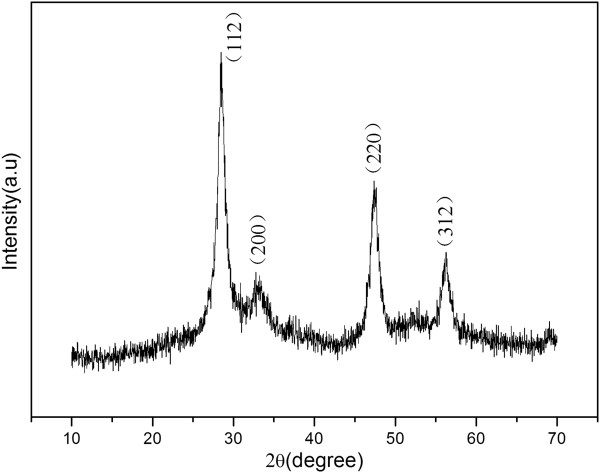
XRD pattern for the Cu2ZnSnS4 nanoparticle. The peaks have been indexed to kesterite Cu2ZnSnS4 (JCPDS No. 26-0575).
In addition, it has been reported that the spectra of Cu2ZnSnS4 and β-ZnS are very similar in the XRD analysis results [17]. Raman spectroscopy analysis is a feasible method to distinguish Cu2ZnSnS4 from β-ZnS [18]. Therefore, we employed Raman spectroscopy to further confirm the structure of the prepared Cu2ZnSnS4 nanoparticle. A Raman spectrum of the prepared Cu2ZnSnS4 nanoparticle over the wave number range of 200 to 450 cm−1 is shown in Figure 2. There is an intensive peak located at approximately 331 cm−1, which suggests the existence of Cu2ZnSnS4[17,19]. The characteristic peaks of β-ZnS located at 348 and 356 cm−1 are not observed in the spectrum [20], indicating the absence of β-ZnS.
Figure 2.
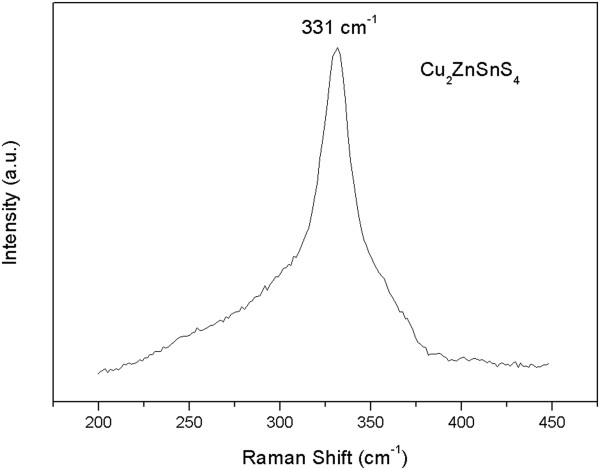
Raman spectra of the prepared Cu 2 ZnSnS 4 nanoparticle.
Surface morphology and microstructure of inorganic semiconductor materials are of vital importance to their optoelectronic properties. Accordingly, the surface morphology of the Cu2ZnSnS4 nanoparticle was studied by SEM. Figure 3a demonstrates a representative surface morphology of the Cu2ZnSnS4 nanoparticle. It can be seen that the Cu2ZnSnS4 nanoparticle possesses similar sizes in diameter and packs uniformly. The average diameter of the Cu2ZnSnS4 nanoparticle is approximately 31 nm calculated from randomly selected 100 nanoparticles. High-resolution transmission electron microscopy (HRTEM) was further employed to investigate the microstructure of the Cu2ZnSnS4 nanoparticle. Figure 3b shows a typical HRTEM image of the Cu2ZnSnS4 nanoparticle. The interplanar spacing of 2.7 Å corresponds to the (200) plane of kesterite Cu2ZnSnS4. The selected area electron diffraction (SAED) pattern shown in Figure 3c suggests the polycrystalline nature of the nanoparticle.
Figure 3.
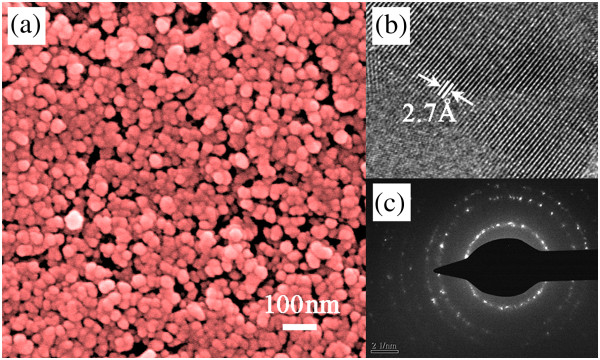
SEM, HRTEM, and SAED images of the prepared Cu2ZnSnS4 nanoparticle. (a) Scanning electron microscopy (SEM), (b) high-resolution transmission electron microscopy (HRTEM), and (c) selected area electron diffraction (SAED) images of the prepared Cu2ZnSnS4 nanoparticle.
To evaluate the photocatalytic performance, we analyzed the decomposition of the (MB) dye in aqueous solution over the Cu2ZnSnS4 nanoparticle under visible light irradiation. Figure 4a presents the time-dependent absorption spectra of MB degradation over the Cu2ZnSnS4 nanoparticle upon visible light irradiation. The five curves in the pattern are the UV-vis spectra of MB solutions extracted at 0 min, 30 min, 60 min, 150 min, and 240 min. It can be observed that the absorbance peak at 665 nm, which is the characteristic absorption peak of MB, reduced slowly with increasing irradiation time. After 240 min, only about 30% of MB was degraded. In addition, it was difficult to further degrade MB by increasing the irradiation time. However, with the addition of 0.1 mL H2O2 (30% aqueous solution), as shown in Figure 4c, almost all MB was degraded after 90 min irradiation. In general, peroxymonosulfate, peroxydisulfate, and H2O2 are often employed to assist in evaluating the photocatalytic properties of semiconductor materials. Both peroxymonosulfate and peroxydisulfate can be driven by visible light for photochemical oxidation [21], while H2O2 can hardly be activated [22]. Additionally, as a typical organic pollutant, MB is stable under visible light irradiation if no photocatalysts are involved. Therefore, the degradation of MB molecules was attributed to the synergetic effect of Cu2ZnSnS4 nanoparticle and H2O2. The H2O2 enhanced the photocatalytic ability through an efficient charge transfer of the photogenerated carriers from the surface of the Cu2ZnSnS4 nanoparticle to the MB molecule. Figure 4b,d illustrates the curves of C/C0, where C0 is the initial concentration of MB and C is the concentration of MB at time t. Insets in Figure 4b,d present the curve of the corresponding ln(C0/C) versus irradiation time. No linear relationship between irradiation time and ln(C0/C) can be observed when employing the Cu2ZnSnS4 as a photocatalyst solely. However, with the assistance of H2O2, a linear relationship between irradiation time and ln(C0/C) is well established, suggesting that the photodegradation of MB over the Cu2ZnSnS4 nanoparticle and H2O2 proceeded through the pseudo-first-order kinetic reaction [23]. The first-order reaction rate constant k 1 was 0.04 min−1, which is comparable to that of TiO2-C hybrid aerogel photocatalysts (0.01 ~ 0.06 min−1) toward the degradation of MB driven by UV light irradiation [24].
Figure 4.
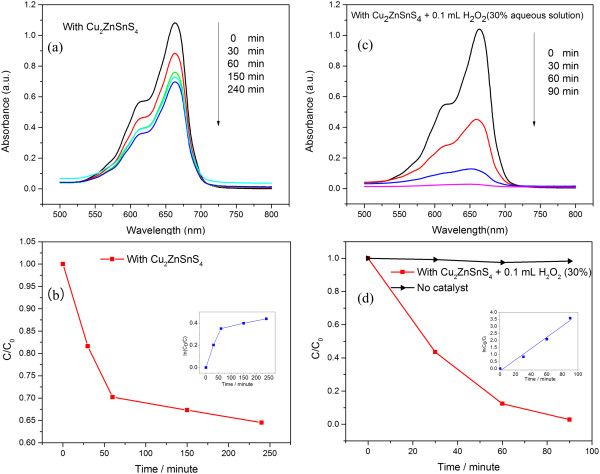
Photocatalytic activity of the Cu2ZnSnS4 nanoparticle toward the photodegradation of methylene blue (MB). (a) Time-dependent UV-vis absorbance spectra of the MB solution using the prepared Cu2ZnSnS4 nanoparticle as a photocatalyst. (b) Curves of the degradation rate of the MB dye with the prepared Cu2ZnSnS4 nanoparticle (C0 is the initial concentration of MB; C is the reaction concentration of MB at time t). The inset shows the ln(C0/C) versus time curve of the photodegradation of MB. (c) Time-dependent UV-vis absorbance spectra of the MB solution using the prepared Cu2ZnSnS4 nanoparticle and 0.1 mL H2O2 as photocatalysts. (d) Curves of the degradation rate of the MB dye with the prepared Cu2ZnSnS4 nanoparticle and 0.1 mL H2O2 as photocatalysts. The inset presents the ln(C0/C) versus time curve of the photodegradation of MB.
According to the experiment results and previous reports, the photocatalytic degradation mechanism by the Cu2ZnSnS4 nanoparticle under visible light irradiation was illustrated in Figure 5 and proposed as follows:
Figure 5.
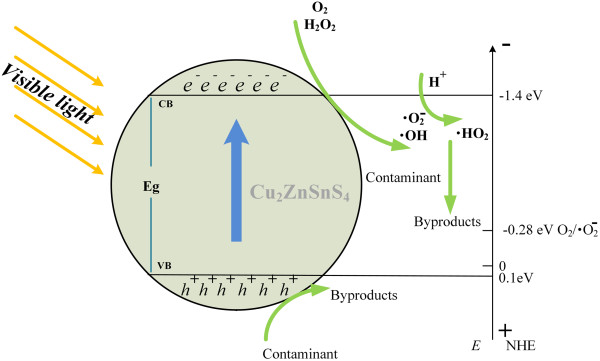
Schematic diagram for charge carrier separation and photocatalytic contaminant decomposition on Cu 2 ZnSnS 4 photocatalyst under visible light irradiation.
| (1) |
When the photogenerated carriers emigrate to the surface of the Cu2ZnSnS4 nanoparticle, the generated Cu2ZnSnS4provides holes, decomposing the absorbed contaminant.
| (2) |
However, due to the top of the valence band of Cu2ZnSnS4 (+0.1 eV versus NHE) is lower than those of · OH/H 2 O (+2.27 eV) and · OH/OH− (+1.99 eV), the Cu2ZnSnS4 nanoparticle cannot further degrade the MB with increasing the irradiation time. More recently, Yu et al.[25] have reported that a noble metal such as Au or Pt can greatly improve the photocatalytic ability of the Cu2ZnSnS4 nanoparticle. The enhancement is attributed to surface plasmon resonance (SPR) effect, which can notably reduce the carrier recombination rate on the surface of the Cu2ZnSnS4 nanoparticle. In our work, with the addition of a small amount of H2O2, the generated Cu2ZnSnS4 can react with the added H2O2, generating · OH, and subsequently photodegrade the absorbed contaminant.
| (3) |
| (4) |
H2O2, as an efficient electron scavenger and a source of · OH with high oxidizing ability, was added here to assist the photodegradation of the contaminant. However, an excess amount of H2O2 will decrease the photocatalytic activity [26]. As shown in Equation 5, the excess H2O2 scavenges the beneficial OH generating a much weaker hyperoxyl radical of .
| (5) |
Besides, the will further react with the remaining · OH forming ineffective oxygen and water.
| (6) |
Conclusions
In summary, the Cu2ZnSnS4 nanoparticle was successfully synthesized by a facile microwave fabrication method. The prepared Cu2ZnSnS4 nanoparticle exhibited a polycrystalline structure with an average diameter of approximately 31 nm. The photocatalytic performance of the Cu2ZnSnS4 nanoparticle toward degradation of MB in aqueous solution was also investigated. Due to the top of the valence band of Cu2ZnSnS4, pure Cu2ZnSnS4 nanoparticle showed a poor visible light photocatalytic ability. However, when employing a small amount of H2O2 as electron scavenger, the photocatalytic performance was greatly enhanced. The first-order reaction rate constant k 1 toward the degradation MB reached as high as 0.04 min−1. The synergetic effect between the Cu2ZnSnS4 nanoparticle and H2O2 was a key to promote the photodegradation efficiency.
Competing interests
The authors declare that they have no competing interests.
Authors’ contributions
ZHZ formulated the idea of investigation and drafted the manuscript. PAZ prepared the Cu2ZnSnS4 nanoparticles. YLL and AE have taken part in acquisition and interpretation of data. HNJ, JW, and HDL directed the research and made corrections to the manuscript. ZMW supervised the study. All authors have read and approved the final manuscript.
Contributor Information
Zhihua Zhou, Email: zhihua18@gmail.com.
Pingan Zhang, Email: 305401023@qq.com.
Yuelai Lin, Email: linyuelai@qq.com.
Eric Ashalley, Email: o.ancient@yahoo.com.
Haining Ji, Email: hainingji@163.com.
Jiang Wu, Email: jiang731@gmail.com.
Handong Li, Email: hdli.phys@gmail.com.
Zhiming Wang, Email: zhmwang@gmail.com.
Acknowledgements
This work was supported by the Fundamental Research Funds for the Central Universities 2672012ZYGX2012J042, the 973 Program (2013CB933800), and the National Natural Science Foundation of China (51272038).
References
- Liao J, Lin S, Zhang L, Pan N, Cao X, Li J. Photocatalytic degradation of methyl orange using a TiO2/Ti mesh electrode with 3D nanotube arrays. ACS Appl Mater Interfaces. 2011;4:171–177. doi: 10.1021/am201220e. [DOI] [PubMed] [Google Scholar]
- Ding D, Long M, Cai W, Wu Y, Wu D, Chen C. In-situ synthesis of photocatalytic CuAl2O4-Cu hybrid nanorod arrays. Chem Commun. 2009;24:3588–3590. doi: 10.1039/b903865e. [DOI] [PubMed] [Google Scholar]
- Chandrappa KG, Venkatesha TV, Sharifah BAH. Electrochemical generation of cubic shaped nano Zn2SnO4 photocatalysts. Nano Micro Letters. 2013;5:101–110. [Google Scholar]
- Hsiao Y-C, Wu T-F, Wang Y-S, Hu C-C, Huang C. Evaluating the sensitizing effect on the photocatalytic decoloration of dyes using anatase-TiO2. Appl Catal B Environ. 2014;148–149:250–257. [Google Scholar]
- De Trizio L, Buonsanti R, Schimpf AM, Llordes A, Gamelin DR, Simonutti R, Milliron DJ. Nb-doped colloidal TiO2 nanocrystals with tunable infrared absorption. Chem Mater. 2013;25:3383–3390. doi: 10.1021/cm402396c. [DOI] [Google Scholar]
- Zhang Z, Luo Z, Yang Z, Zhang S, Zhang Y, Zhou Y, Wang X, Fu X. Band-gap tuning of N-doped TiO2 photocatalysts for visible-light-driven selective oxidation of alcohols to aldehydes in water. RSC Advances. 2013;3:7215–7218. doi: 10.1039/c3ra40518d. [DOI] [Google Scholar]
- Chen C, Cai W, Long M, Zhou B, Wu Y, Wu D, Feng Y. Synthesis of visible-light responsive graphene oxide/TiO2 composites with p/n heterojunction. ACS Nano. 2010;4:6425–6432. doi: 10.1021/nn102130m. [DOI] [PubMed] [Google Scholar]
- Zhang J, Chen G, Chaker M, Rosei F, Ma D. Gold nanoparticle decorated ceria nanotubes with significantly high catalytic activity for the reduction of nitrophenol and mechanism study. Appl Catal B Environ. 2013;132–133:107–115. [Google Scholar]
- Gai Y, Li J, Li S-S, Xia J-B, Wei S-H. Design of narrow-gap TiO2: a passivated codoping approach for enhanced photoelectrochemical activity. Phys Rev Lett. 2009;102:036402. doi: 10.1103/PhysRevLett.102.036402. [DOI] [PubMed] [Google Scholar]
- Jiang B, Zhang P, Zhang Y, Wu L, Li HX, Zhang DQ, Li GS. Self-assembled 3D architectures of Bi2TiO4F2 as a new durable visible-light photocatalyst. Nanoscale. 2012;4:455–460. doi: 10.1039/c1nr11331c. [DOI] [PubMed] [Google Scholar]
- Sajjad S, Leghari SAK, Zhang JL. Nonstoichiometric Bi2O3: efficient visible light photocatalyst. Rsc Advances. 2013;3:1363–1367. doi: 10.1039/c2ra22239f. [DOI] [Google Scholar]
- Wu W, Liang S, Chen Y, Shen L, Yuan R, Wu L. Mechanism and improvement of the visible light photocatalysis of organic pollutants over microcrystalline AgNbO3 prepared by a sol–gel method. Mater Res Bull. 2013;48:1618–1626. doi: 10.1016/j.materresbull.2013.01.011. [DOI] [Google Scholar]
- Zhu MS, Chen PL, Liu MH. Graphene oxide enwrapped Ag/AgX (X = Br, Cl) nanocomposite as a highly efficient visible-light plasmonic photocatalyst. ACS Nano. 2011;5:4529–4536. doi: 10.1021/nn200088x. [DOI] [PubMed] [Google Scholar]
- Chen S, Walsh A, Gong X-G, Wei S-H. Classification of lattice defects in the kesterite Cu2ZnSnS4 and Cu2ZnSnSe4 earth-abundant solar cell absorbers. Adv Mater. 2013;25:1522–1539. doi: 10.1002/adma.201203146. [DOI] [PubMed] [Google Scholar]
- Xinkun W, Wei L, Shuying C, Yunfeng L, Hongjie J. Photoelectric properties of Cu2ZnSnS4 thin films deposited by thermal evaporation. J Semicond. 2012;33:022002. doi: 10.1088/1674-4926/33/2/022002. [DOI] [Google Scholar]
- Wang L, Wang W, Sun S. A simple template-free synthesis of ultrathin Cu2ZnSnS4 nanosheets for highly stable photocatalytic H2 evolution. J Mater Chem. 2012;22:6553–6555. doi: 10.1039/c2jm16515e. [DOI] [Google Scholar]
- Fernandes PA, Salome PMP, da Cunha AF. Growth and Raman scattering characterization of Cu2ZnSnS4 thin films. Thin Solid Films. 2009;517:2519–2523. doi: 10.1016/j.tsf.2008.11.031. [DOI] [Google Scholar]
- Fernandes PA, Salomé PMP, da Cunha AF. Study of polycrystalline Cu2ZnSnS4 films by Raman scattering. J Alloy Compd. 2011;509:7600–7606. doi: 10.1016/j.jallcom.2011.04.097. [DOI] [Google Scholar]
- Zou C, Zhang LJ, Lin DS, Yang Y, Li Q, Xu XJ, Chen X, Huang SM. Facile synthesis of Cu2ZnSnS4 nanocrystals. Crystengcomm. 2011;13:3310–3313. doi: 10.1039/c0ce00631a. [DOI] [Google Scholar]
- Serrano J, Cantarero A, Cardona M, Garro N, Lauck R, Tallman RE, Ritter TM, Weinstein BA. Raman scattering in beta -ZnS. Phys Rev B. 2004;69:014301. [Google Scholar]
- Zhou G, Sun H, Wang S, Ming Ang H, Tadé MO. Titanate supported cobalt catalysts for photochemical oxidation of phenol under visible light irradiations. Sep Purif Technol. 2011;80:626–634. doi: 10.1016/j.seppur.2011.06.021. [DOI] [Google Scholar]
- Sun H, Liu S, Liu S, Wang S. A comparative study of reduced graphene oxide modified TiO2, ZnO and Ta2O5 in visible light photocatalytic/photochemical oxidation of methylene blue. Appl Catal B Environ. 2014;146:162–168. [Google Scholar]
- Mohamed MM, Al-Esaimi MM. Characterization, adsorption and photocatalytic activity of vanadium-doped TiO2 and sulfated TiO2 (rutile) catalysts: degradation of methylene blue dye. J Mol Catal A Chem. 2006;255:53–61. doi: 10.1016/j.molcata.2006.03.071. [DOI] [Google Scholar]
- Shao X, Lu W, Zhang R, Pan F. Enhanced photocatalytic activity of TiO2-C hybrid aerogels for methylene blue degradation. Sci Rep. 2013;3:3018. doi: 10.1038/srep03018. [DOI] [PMC free article] [PubMed] [Google Scholar]
- Yu X, Shavel A, An X, Luo Z, Ibáñez M, Cabot A. Cu2ZnSnS4-Pt and Cu2ZnSnS4-Au heterostructured nanoparticles for photocatalytic water splitting and pollutant degradation. J Am Chem Soc. 2014;136:9236–9239. doi: 10.1021/ja502076b. [DOI] [PubMed] [Google Scholar]
- Shang M, Wang W, Sun S, Ren J, Zhou L, Zhang L. Efficient visible light-induced photocatalytic degradation of contaminant by spindle-like PANI/BiVO4. J Phys Chem C. 2009;113:20228–20233. doi: 10.1021/jp9067729. [DOI] [Google Scholar]


